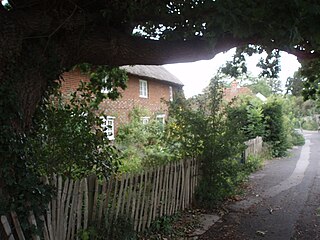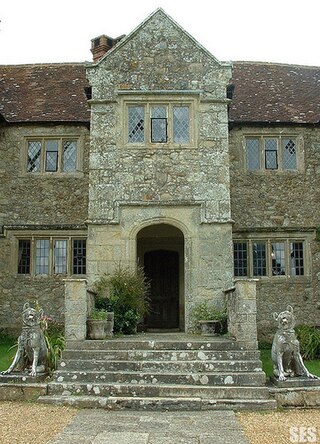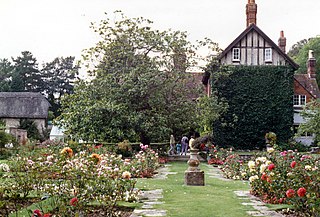
Carisbrooke Castle is a historic motte-and-bailey castle located in the village of Carisbrooke, Isle of Wight, England. Charles I was imprisoned at the castle in the months prior to his trial.

Thorley is a village and former civil parish, now in the parish of Yarmouth, on the Isle of Wight, England. It is 1+1⁄2 miles (2.4 km) from Yarmouth in the northwest of the island and is 9 miles (14 km) west from Newport. In 1931 the parish had a population of 125.

Warblington is a suburb of Havant, a town in Hampshire, England. Warblington used to be a civil parish, and before that was part of the Hundred of Bosmere.

The Worsley family is an English family that is derived from Sir Elias de Workesley, a Norman knight who was a youth at the time of the Norman conquest. He later accompanied Duke Robert II of Normandy on the First Crusade and was buried at Rhodes.
Puckaster is a hamlet on the Isle of Wight, England. Puckaster is on the southern coast of the Isle of Wight, south of Niton, between St. Catherine's Point and Binnel.

Sir Richard Worsley, 7th Baronet,, of Appuldurcombe House, Wroxall, Isle of Wight, was a British politician who sat in the House of Commons between 1774 and 1801. He was a noted collector of antiquities.

St Olave's Church, Gatcombe is a parish church in the Church of England located in Gatcombe, Isle of Wight.

Warblington Castle or Warblington manor was a moated manor near Langstone in Havant parish, Hampshire. Most of the castle was destroyed during the English Civil War, leaving only a single gate tower, part of a wall, and a gateway. The property, now in the village of Warblington, is privately owned and does not allow for public access.

Arreton Manor is a manor house in Arreton, Isle of Wight, England. Its history is traced to 872 AD to the time of King Alfred the Great and his parents. It was left by King Alfred by his will to his youngest son Aethelweard. Once owned by William the Conqueror, as mentioned in the Domesday Book in 1086, in the 12th century it became part of Quarr Abbey and was used by the monks for over 400 years. In 1525, it was leased to the Leigh family. The manor was rebuilt between 1595 and 1612. Built in Jacobean style, it is in the shape of a "H".

The Great Budbridge Manor is a manor house just south of Merstone, near Arreton, Isle of Wight, England. Fish ponds on the grounds appear medieval.

Morton Manor is a manor house originating in the 13th century, in Brading, Isle of Wight, England. It is located 1 mile (1.6 km) southwest of Sandown Road. The fairly small 14th-century house was modified in the 19th century. Constructed of varied materials, it was refurbished and extended in the early 20th century in an Arts and Crafts style. The house has a Tudor fireplace in the dining room, with William De Morgan green glazed tiles, and the manor includes a small museum of rural life.

Nunwell House, also Nunwell Manor, is a historic English country house in Brading, Isle of Wight. Located 3 miles (4.8 km) south of Ryde, the Tudor and Jacobean style house also has later additions. The house contains family militaria. It was occupied by the Oglander family from Norman times until 1980. Nunwell House is a Grade II* listed building.
Gatcombe House is a 15,234 sq ft (1,415.3 m2) manor house in Gatcombe on the Isle of Wight, England. The original building was constructed by the Stur (Estur) family as noted in the Domesday Book. St. Olave's Church, built next to the manor to serve as its chapel, was dedicated in 1292. It also belonged at one time to the Lisles of Wootton.
Merston Manor is a manor house in Merstone on the Isle of Wight, England. The manor was first mentioned in the Domesday Book. Prior to the Norman Conquest, Merston Manor was owned by the Brictuin family. The present home, built in 1605 in the Jacobean style by Edward Cheeke, was rebuilt in the Victorian era. This structure may be the oldest brick house on the Island. The manor now belongs to the Crofts family.

Wolverton Manor is a manor house in Shorwell, on the Isle of Wight, England. The original house was started by John Dingley, Deputy Governor of the Isle of Wight. The Jacobean style home, built by Sir John Hammond after the death of Sir John Dingley, is the second house built on the site. There is a two-storey porch which features a flat roof and hollow angle columns.

Northcourt Manor is one of three manor houses, along with Woolverton and Westcourt, that is located in Shorwell, on the Isle of Wight, England. It was begun by Sir John Leigh, Deputy Governor of the Island, in 1615, but was unfinished at his death. Northcourt is currently in use as a hotel.

Great East Standen Manor is a manor house on the Isle of Wight, England. Its history dates to the Norman Conquest; and it was allegedly once the residence of Princess Cicely, the daughter of Edward IV, following her third marriage to Sir Thomas. The front is 18th-century and includes five bays that are irregularly spaced. Grey headers and red brick dressings are featured, as are windows with slightly segmental tops and a large chimneystack, dated 1768. The 18th-century Standen House is nearby.

Sheat Manor is a manor house in Chillerton, on the Isle of Wight, England. Considered to be one of the island's antiquities, Sheat manor house, is a fine old gabled mansion now used as a farmhouse. It has a pond and swans. It contains some interesting Jacobite carving. Sheat was one of the few properties whose Anglo-Saxon owner, Alaric, was not disturbed by the Norman invasion. It was run by the Urry family for some time.
Landguard Manor is a manor house in Shanklin on the Isle of Wight, England. Mentioned in the Domesday Book, over the centuries it was home to numerous notable gentlemen. It is a Grade II listed building. One of the finest known portraits by Sir Thomas Lawrence, English portrait painter and president of the Royal Academy, is located in its drawing room.

Sir Robert Worsley 4th Baronet was a British politician who sat in the House of Commons from 1715 to 1722.
















